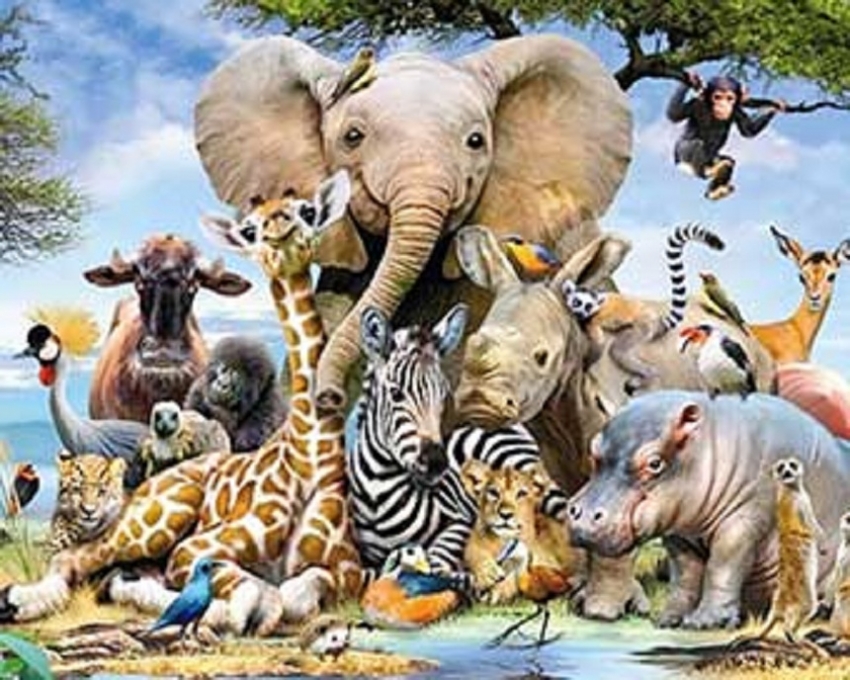Are all beings the same? Yes, the human, the hammerhead worm, oyster, chicken and the shark : all of us have the same emotions, fears, lusts and intelligence. Yet, the human eats some, kills some for sport, uses some to wear as accessories, destroys some as pests. The human is the ultimate cannibal : eating his own kind, humans in another form, again and again.
Here are some random bits of research that show you the similarities between humans and every other species.
* Many people need coffee as a stimulant to wake up. It also improves memory. A study by Wright, Baker, Palmer et al, published in Science "Caffeine in Floral Nectar", reveals that bees similarly like caffeine to get a buzz.
The honeybee collects nectar from flowers and this helps pollinate them. Certain flowers, such as citrus and coffea, includes low doses of caffeine in their nectar in order to attract honeybees and keep them returning! The researchers found that bees found caffeine rewarding and they remembered the smell of caffeine upto three days later.
These clever flowers have evolved caffeine-laced nectar in order to "hook" the bees and ensure their reproductive success. Caffeine actually serves a dual purpose in the flower – it wards off herbivores/plant pests as well.
* It was considered that sparrows are monogamous but a study, published in The American Naturalist, followed 200 males and 194 females as they formed 313 unique monogamous pairs and hatched 863 broods on Lundy. Some sparrow ‘divorces’ occurred—but most changes of life partner were due to a death.
However, some females cheated on their mates and were promiscuous by habit. This was usually with males that were fitter than their own mates. But, researchers said, that cheating came with a cost—the cheating female’s partner will provide less food for their nest of young. If the males know that not all the chicks in their nest are likely to be theirs they make a decision to provide less. Males changed their behaviour based on their partner.
Males monitor the times the females spend away from the nest and are usually able to tell if their partner is unfaithful.
* Are teenage humans the only ones that seek out mild altering drugs in groups ? In the wildlife documentary, Dolphins: Spy in the Pod, by John Downer, young dolphins are seen carefully manipulating a certain kind of puffer fish which, if provoked, releases a nerve toxin as a defensive chemical. They passed it between them for up to 30 minutes at a time chewing gently on it. In small enough dose, this toxin can have trance-inducing qualities and the dolphins know it. They handle it in a way that shows that it’s not the first time they’re doing it, and they appear to have worked out a way to make the fish release just the right amount. The marine mammals then enter what seems to be a trance-like state, hanging around with their noses at the surface, as if fascinated by their own reflection.
* Research done by Northampton University indicates that cows have "best friends." For the study, cows were penned for 30 minute intervals twice, once with a partner, a "best friend," and once with a cow that they did not know. The heart rates of the cows were measured when paired with their best friend – they were significantly lower and they experienced less stress overall. The notion that cows have best friends indicates that all cows have personalities and a desire, not unlike our own, to develop deep connections with others. Not only are cows more calm when they’re around a buddy, but they’re actually smarter too. In a 2014 study, researchers from the University of British Columbia found that young calves, that live alone, perform worse on tasks of cognitive skill than those that live with a best friend.
* Are human beings the only ones that gamble ? Pigeons gamble just like humans.
Research done in the University of Kentucky, published in the journal Proceedings of the Royal Society, found that pigeons given the choice, to peck a light that would give them three food pellets each time, universally preferred a light that would give them a payout of 10 pellets 20 percent of the time. Which means they got less 2 pellets on an average instead of three.
Hungry pigeons were trained to peck lights for food. They learned that if they pecked a light on the right, they would see one of two colours, like yellow or blue.Ten seconds later, the pigeon would certainly get three food pellets. If the pigeon pecked the other light on the left, the light would flash either red or green. If red, the pigeons would get 10 pellets 10 seconds later. If green, the pigeons would get nothing. That light was the equivalent of taking a gamble. 82% of the birds acted like seasoned gamblers, picking the risky light with the 10-or-nothing outcome. On the right the pigeon gets 50 % more food yet the bird chooses the left almost always! The same phenomenon could explain why human gamblers ignore their losses and focus on their rarer and hopefully larger wins, working against their own best interests.
There are several parallels between animal and human gambling. For example, pigeons that live in enriched environments make less risky choices, which matches human studies finding that people who are satisfied with their lives also tend to gamble less than those who are dissatisfied. And hungry pigeons, like people with less money, tend to gamble more, despite the obvious downsides of taking risks when you have more to lose.
* Each year, during the winter, thousands of giant Australian cuttlefish gather on the southern coast of the continent to mate. The competition between males for the females is intense. On average, four males fight over each female, but the ratio can be as high as eleven to one. Each large male, who wins the challenges, guards his mate closely. But do the little guys give up ? They disguise themselves as females, according to research done by marine biologists at Woods Hole Marine Biological Laboratory, taking on a mottled colouring, hiding some arms and altering the shape of the visible ones. They sneak in under the rock where the female lives, impregnate her and then leave. The team also found that the mimics could change their appearance as fast as 10 times in 15 minutes. The mimicry is sophisticated, and the pace at which they are able to change is incredible. Reminds me of the men that pretended to be eunuchs in order to access royal harems.




















